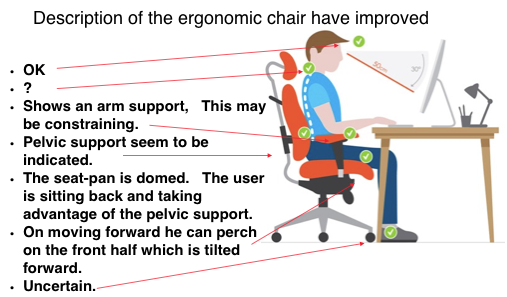Already described are the adverse effects of mid-upright sitting →

Derived from these findings are the ergonomic requirements to help remediate the adverse effect of the Upright seated mode. Essentially there are two.
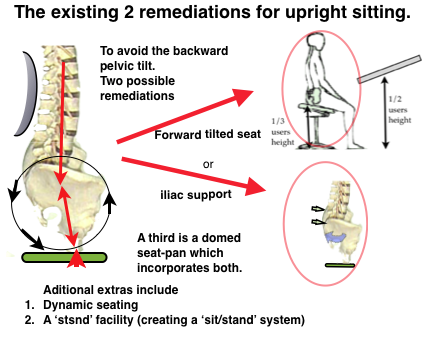
Derived from these findings are the ergonomic requirements to help remediate the adverse effect of the Upright seated mode. Essentially these are two.
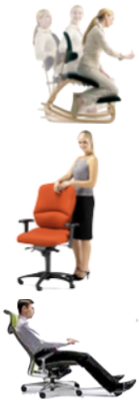 ☛forward tilted seat→,
☛forward tilted seat→,- ☛Pelvic support→,
- The Ischial off-load system. A third, now often used for Upright seated mode remediation in a number of chairs is derived from a combination of the 2 above. The seat-pan is convex so that the front half acts as a forward tilted seat and the back half allows the user to sink back into the back support. Hopefully this is correct iliac support.
These remediations, aimed to give improved ergonomics for any chair should be examined carefully as they are commonly misapplied due to failure to understand the underlying scientific basis. Some insight can be gleaned from ☛Various chairs. How do they measure up?→
The above diagram (but not my comments) was derived from https://www.chairoffice.co.uk/blog/the-ergonomics-of-a-chair-explained/ with the following advice …
- A seat height that ranges from 16 to 21 inches off the floor should work for most people.
- A proper seat depth should leave between 2 and 4 inches between the edge of the seat and the back of your knees. If the seat is too far forward, it may put undue pressure at the back of the knees.
Seat tilt. Good ergonomic chairs will allow the seat to tilt, which allows for correct positioning of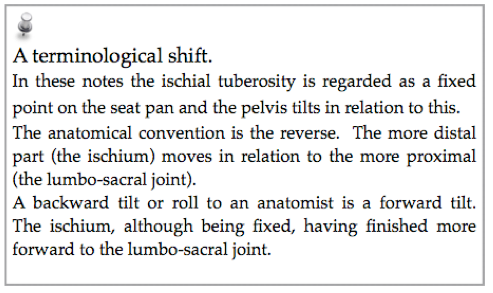 the pelvis. Anterior pelvic tilt is a posture problem that affects almost everyone who sits a lot, which is why it’s important to keep the pelvis in a neutral position when sitting, with 80 degree angles at the hips, knees and ankles. (Anterior pelvic tilt is used in the anatomical sense. In the popular use is a Backward tilt.)
the pelvis. Anterior pelvic tilt is a posture problem that affects almost everyone who sits a lot, which is why it’s important to keep the pelvis in a neutral position when sitting, with 80 degree angles at the hips, knees and ankles. (Anterior pelvic tilt is used in the anatomical sense. In the popular use is a Backward tilt.) - Backrest Lumbar support. This refers to the support given to your lower back, and is an essential feature of an ergonomic chair. Ergonomic chairs support the natural ‘S’ shape of the spine, which prevents slumping and reduces stress on the spine and the pelvis. An adjustable backrest allows users to align the curve in the chair with the curve in their spine, for optimal support. (Misleading as no distinction is made beweem Lumbar (Bad) and pelvic (Good).
- Backrest recline An adjustable backrest allows for greater tailored positioning for the user, as they can move the backrest to more specifically support their natural spine position. Using this feature throughout the day allows the backrest to take some of the weight from your upper body, reducing the pressure on your spinal disks and muscles. (2T Requirement 6. Variability at head and feet only. These are the most variable parts of the human body, in the reclined mode. Adjustments avoided elsewhere. ☛Adjustments→. )
- The swivel in an ergonomic chair helps users with their manoeuvrability, making it easier to reach different points of their desks without having to strain excessively. (and to escape from the chair).
- Armrests help to reduce tension in the upper body and allow the shoulders to relax. However, armrests should not be used when typing as this reduces overall arm movement, which in turn increases wrist movement leading to strain on the forearm muscles. (Contradictory. Do we or don’t we use armrests? One that tilts back out of the way is an answer.)
- Headrests supports the back of the head and the upper neck, reducing tension in the shoulders and upper torso. ( Of use for contemplating the ceiling in an upright work mode. Important for the 2T reclined mode, Requirement 4. A correctly placed head/neck-rest is required so that the occupant has no need to move the neck to establish the task-related visual field.)
- The material should not cause the user’s back to sweat. However, the materials used will depend on the budget; high-end ergonomic chairs will use leather or velvet.
 This not unreasonable account shows that remediations of the upright seated mode has come to the end of the road. They are not a solution to fully reduce the incidence of backache (LBP). This would require a new technical fix that addresses all identified adverse bio-mechanics effects of prolonged upright sitting. Next ☛ A FULL SOLUTION→
This not unreasonable account shows that remediations of the upright seated mode has come to the end of the road. They are not a solution to fully reduce the incidence of backache (LBP). This would require a new technical fix that addresses all identified adverse bio-mechanics effects of prolonged upright sitting. Next ☛ A FULL SOLUTION→
Helpful pages include
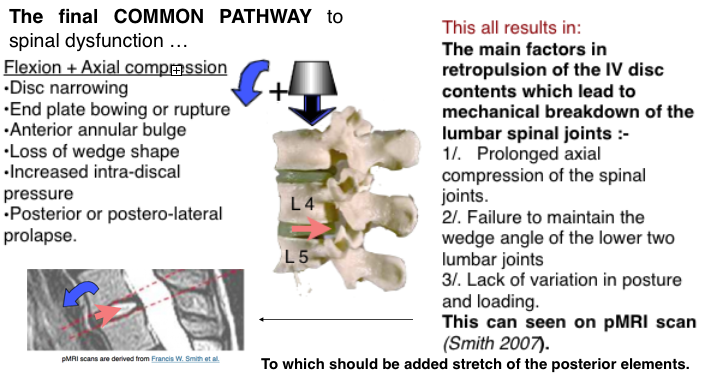 The effects that all need to be avoided for an ergonomic solution to spinal dysfunction.
The effects that all need to be avoided for an ergonomic solution to spinal dysfunction.

